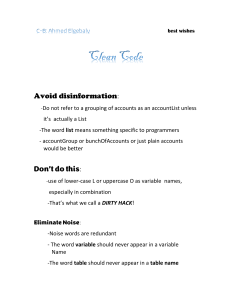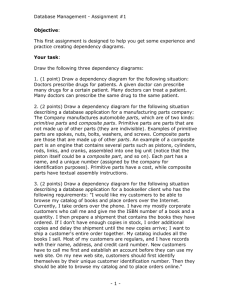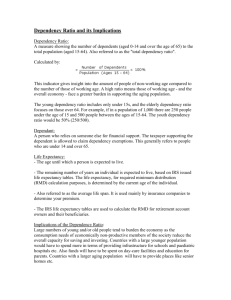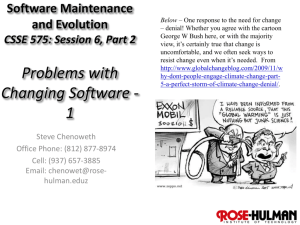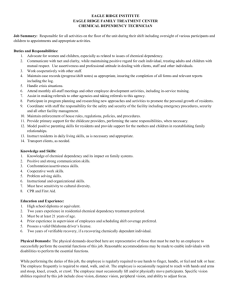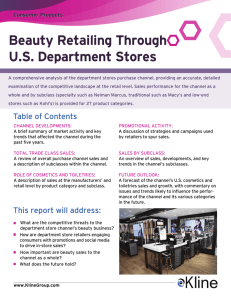Breaking Dependencies - Rose
advertisement
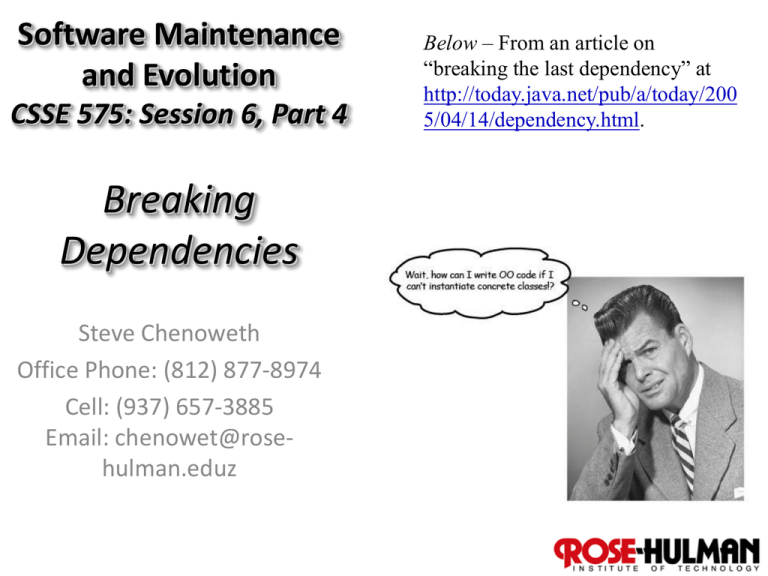
Software Maintenance and Evolution CSSE 575: Session 6, Part 4 Below – From an article on “breaking the last dependency” at http://today.java.net/pub/a/today/200 5/04/14/dependency.html. Breaking Dependencies Steve Chenoweth Office Phone: (812) 877-8974 Cell: (937) 657-3885 Email: chenowet@rosehulman.eduz 1 We saw that almost all software changes… • Software Changes and Entropy Results – Ripple-Effects of Software Changes – Changes on Changes – Hydra-Effect… Reprise - Symbol for Creative Entropy, a company who build iPhone and iPod apps. From http://www.creativeentropy.com/ • Feathers’ book – how to make those changes easy to accomplish – Main trick – Get it into a test-first harness. – Doing that often requires breaking the same dependencies that make the code easy to extend. 2 Ch 25 – Breaking Dependencies • A whole lot of tricks for avoiding testing difficulties – Pick a class you want to work with, but can’t test Not always easy to isolate – Figure out where it should have things you want to test. a “Seam” but doesn’t http://howtosurviveschool10 1.blogspot.com/ – Find a way to break that dependency – This presentation’s concept – pick some of those and apply them to making your code more test-friendly 3 Ch 25 – Ways to break ‘em • • • • • • Adapt parameter Break out method object Definition completion Encapsulate global references Express static method Extract and override – – Call – Factory method – Getter • Extract – – Implementer – Interface • Introduce – – Instance delegator – Static setter • Link substitution • Parameterize – – Constructor – Method • • • • Primitive parameter Pull up feature Push down dependency Replace – – Function with function pointer – Global reference with getter • • • • Subclass and override method Supersede instance variable Template redefinition Text redefinition 4 What’s “Extract Interface”? • To build test code to replace a part of a messy call – – Create an interface to that messy call, incrementally add only the parts of the real object that you need – The compiler will tell you what’s missing – Make a fake object that implements these corresponding parts, for testing 5 Some of these should look familiar • Subclass and override method, for example – We already discussed, in earlier examples – You invent a “testing subclass” and invoke it instead of the real class, to get rid of some dependency – Many of the other Ch 25 methods are variations on this 6 A variation on this one… • Push down dependency – can be used when you’d have to define too many interfaces and substitute in too many places, to subclass and override • Idea is – – Make the original class abstract, where these dependency problems occur – Subclass it in one way for testing – Subclass it in another to instantiate those problem dependencies for production 7 Common strategy in Ch 25 • Build a test harness that includes all these overrides and other ways to simulate things where you need “Seams” • Make it clear when you use the test harness or are making it “production.” Perhaps – – The test harness is for a whole system, like in integration testing, or – The test harness is just for unit testing this class 8 Additional Ch 25 tips • Be careful creating code that enables testing: – Since the code is not yet testable (till you are done), these changes themselves aren’t “testable” • Thus, – Use copy and paste, versus typing – Use code reviews (other people catch errors) – Define testing interfaces (compiler catches errors) • Use “mock object libraries” instead of creating your own – See next page for examples! 9 10 Assignment and Milestone Reminders • Journals and Milestone this week– – See assignments on course web site. Above – Seams in jeans. From http://67pics.com/view.php?q=Pictures %20Of%20Seams&url=http://www.cov ersforyou.us/big/overlapped_double_sti ched_seams_big.jpg 11
